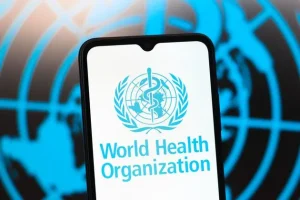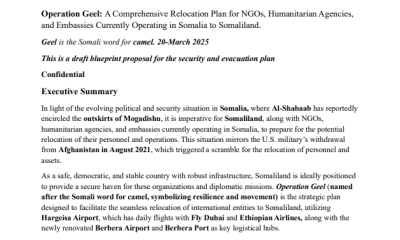Health
Inside Somalia’s Failing Hospitals as Donor Support Dries Up

Somalia’s Collapsing Hospitals Expose the Human Cost of Aid Cuts and Endless War.
MOGADISHU — When Yusuf Bulle carried his severely malnourished 3-year-old son from a remote village in southern Somalia to Mogadishu, Banadir Hospital was his only hope. “Where I come from, there is no hospital,” he said, standing in a crowded pediatric ward. After fifteen days, his child survived — but in much of Somalia, thousands of others are not as fortunate.
A nationwide collapse of Somalia’s already fragile health system is accelerating after the Trump administration’s dismantling of the U.S. Agency for International Development earlier this year, a decision that wiped out critical funding for clinics and frontline medical staff.
The result is a health crisis layered atop an ongoing war against al-Shabab and deep donor fatigue that is eroding the last functioning institutions in one of the world’s poorest countries.
Somalia’s deputy health minister, Mohamed Hassan Bulaale, said the cuts eliminated more than 6,000 health workers and affected up to 2,000 facilities — a devastating blow in a nation where basic care is already scarce. “Wherever you go, it’s donors that keep the hospitals alive,” he said.
Security Gains, Social Collapse
While deadly al-Shabab bombings have decreased under President Hassan Sheikh Mohamud’s “total war” campaign, the government’s overwhelming focus on security has drained attention from collapsing public services.
Civic leaders warn that the cost of military gains is becoming painfully clear in Mogadishu’s hospitals, where wards depend almost entirely on UN agencies and humanitarian groups to function.
Somalia’s Ministry of Health received $91 million in this year’s national budget — nearly double last year’s allocation — but analysts say the apparent increase masks a grim reality: almost all of the funding came from external donors. As Mahad Wasuge of the Somali Public Agenda put it, “Security remains the first priority. Everything else is an afterthought.”
In rural areas, “everything else” often means nothing at all.
Hospitals Held Together by Foreign Funding
At Banadir Hospital, the main public referral hospital in Mogadishu, even the unit for severely malnourished children depends entirely on donor money funneled through Concern Worldwide. Dr. Mohamed Haashi says 37 employees lost their jobs when U.S. aid was cut; only 13 remain, all funded by Concern. The milk, food, and medicine keeping children alive come from the same pipeline.
Across the city at De Martino Hospital — a century-old facility established during Italian colonial rule — administrators worry their lifeline will soon snap. Contracts with two humanitarian groups expire in late 2025. “Now it looks like donors are fatigued,” said the hospital’s director, Dr. Abdirahim Omar Amin, gesturing toward laboratory equipment purchased almost entirely through aid.
De Martino’s pediatric wing was treating dozens of children with diphtheria, a disease easily prevented by routine vaccination. But rural parents, fearing militant attacks on clinics, have stopped bringing their children in.
“Even the limited public hospitals that function rely almost entirely on donors,” said Wasuge. “The government gives no direct budget to keep them alive.”
A State Adrift
The story of Somalia’s hospitals mirrors the story of the state itself: structures shattered by decades of civil war, partially rebuilt by foreign funds, and perpetually one crisis away from collapse. After the fall of Siad Barre in 1991, many public buildings became shelters for the displaced. Some never reopened.
Today, the federal government operates from a heavily fortified enclave near Mogadishu’s airport, reliant on African Union peacekeepers, U.S. airstrikes, and foreign advisers in a country where multiple powers — from Turkey to Gulf states — compete for influence on the Indian Ocean and the Gulf of Aden.
Despite that geopolitical attention, Somalia has “no national healthcare plan,” said Mohamed Adam Dini, a parliamentarian from Puntland. “A lot of diseases are spreading unchecked. There is no political plan — so how can there be a health plan?”
For Somalis like Amina Abdulkadir Mohamed, who recently gave birth at De Martino because she knew she wouldn’t be asked to pay, the crisis is already personal. “I was told there is free medication,” she said. How long that remains true depends entirely on donors who are, increasingly, leaving.
Health
Is Our Rice Addiction Fueling Somaliland’s Cancer Crisis?

EXPOSÉ: Somaliland’s Daily Poison — Is a Contaminated Rice Supply Driving Our Cancer Surge?
WARYATV INVESTIGATION | HARGEISA — For years, rice has been the quiet ruler of the Somali kitchen: cheap, filling, familiar. But as cancer cases rise at an alarming pace and Somaliland families drain their savings traveling to India for treatment, a devastating question now hangs over the dinner table: Is our national staple slowly poisoning us?
A respected medical expert, Dr. Cabdirisaaq Cartan, has broken ranks with the silence in the health sector, urging the public to stop eating rice immediately—a warning he links directly to the country’s cancer spike and to widespread consumption of expired, poorly stored imports.
His message is blunt, and the science backing it is even harsher.
The Hidden Carcinogen Sitting in Every Somaliland Kitchen
Rice is uniquely efficient at absorbing arsenic, a toxic heavy metal classified globally as a Group 1 carcinogen. Because rice is grown in flooded conditions, it pulls arsenic out of the soil far more aggressively than other grains.
Across the world, more than 3.5 billion people depend on rice. But the danger becomes acute when it is eaten three times a day, every day — exactly the pattern in Somali households.
Long-term arsenic exposure is linked to higher rates of lung, bladder, and skin cancers, and a growing body of research shows impacts on heart disease, pregnancy outcomes, and child development.
Somaliland’s situation is even more alarming. We are not consuming small, occasional bowls of rice — we are consuming mountains of it, often from unknown suppliers, from warehouses with questionable storage conditions, and sometimes past the expiration date.
The Basmati Myth
Most rice imported into Somaliland markets — Basmati from South Asia — carries lower arsenic levels, but not safe levels. The largest long-term studies, including the California Teachers Study, found:
-
A measurable increase in breast and bladder cancer risk linked to regular rice consumption.
-
Scientists warned that populations like Somalis, who eat rice as a staple rather than a side dish, face significantly higher lifetime risk.
Even “low arsenic” rice becomes dangerous when eaten in the volumes common across Somaliland.
A National Silence — and a Public Paying the Price
Despite the warnings from Dr. Cartan, the Ministry of Health has issued no investigation, no data, no response. Berbera port continues to receive rice shipments with no mandatory arsenic testing, no transparent quality controls, and no public reporting.
Meanwhile, hundreds of Somaliland families go bankrupt each year seeking cancer care in India — the human cost of a crisis no one in government has bothered to confront.
Dr. Cartan also raised a painful truth: Somaliland’s media rarely investigates this kind of public health threat. Photo-ops with politicians dominate airtime, while potentially contaminated food continues entering the national market.
What Families Must Do — Starting Today
This is not fearmongering. It is a public safety alert.
Until the government enforces stricter controls, Somalilanders must protect themselves:
1. Reduce daily rice intake.
Replace it with millet (misago), corn, oats, barley, sorghum, or quinoa.
2. Wash and cook properly.
Rinse thoroughly, then cook rice in 6:1 water and drain the excess — a method proven to remove much of the arsenic.
3. Protect children and pregnant women.
They are most vulnerable to arsenic exposure. Their rice consumption should be strictly limited.
A National Health Emergency We Can No Longer Ignore
Cancer is destroying Somaliland households. The financial burden is crushing families. The silence from leadership is indefensible.
Dr. Cartan’s warning is not an attack on culture — it is a call for survival.
Somaliland must demand transparency, enforce food safety standards, and confront the deadly possibility that the very meal we trust most may be the one hurting us.
Health
Over Half a Million Blood Pressure Pills Recalled for Cancer-Linked Impurities

FDA Warns of Cancer-Linked Impurities in Popular Blood Pressure Medicine.
Health The U.S. Food and Drug Administration (FDA) has announced a major recall of more than 500,000 bottles of the blood pressure medication prazosin hydrochloride, citing the presence of N-nitrosamines, chemical compounds associated with an increased risk of cancer.
The recall, initiated by Teva Pharmaceuticals, applies to 1 mg, 2 mg, and 5 mg tablets of prazosin hydrochloride, an FDA-approved alpha-blocker commonly prescribed to treat high blood pressure and, in some cases, PTSD-related nightmares and prostate issues.
According to the FDA’s enforcement notice, the recall is categorized as a Class 2 event, meaning the medication “may cause temporary or medically reversible adverse health consequences,” though the likelihood of serious harm is considered remote.
The affected lots were found to contain elevated levels of N-nitrosamine impurities, specifically “N-nitroso Prazosin impurity C.” Nitrosamines are environmental contaminants found in water, certain foods, and cured meats, but at high levels in medications, they pose long-term carcinogenic risks.
The FDA emphasized that the danger arises primarily from sustained exposure over time, not short-term use.
While Teva and the FDA have not issued direct instructions for patients to discard the medication, pharmacists advise consumers to check the lot number on their prescription bottles and consult their doctor or pharmacist before making any changes.
“Stopping your blood pressure medication suddenly can be more dangerous than continuing it,” noted a Harvard Health report cited by the agency.
Teva has not confirmed how the impurities formed but said it is cooperating with regulators to remove affected products from circulation.
The FDA added that such impurities can develop during manufacturing or prolonged storage, particularly under certain temperature or chemical conditions.
Health experts recommend that patients continue their prescribed treatment until they speak with their healthcare provider. Pharmacists can help verify whether a specific batch number falls under the recall list available on the FDA website.
The recall underscores a growing concern in the U.S. pharmaceutical supply chain, where nitrosamine contamination has triggered multiple recalls over the past five years, including for blood pressure and diabetes medications.
For patients, vigilance remains key: check your lot number, contact your pharmacist, and seek medical guidance before stopping any medication.
Health
Unpacking the High Risk for Somali Mothers in Childbirth

A Common Procedure, A Dangerous Complication
A new study has brought to light a significant and alarming health risk for women in Somalia: low blood pressure during childbirth. Published in the journal BMC Pregnancy and Childbirth, the research focused on mothers undergoing cesarean sections at the Recep Tayyip Erdoğan Hospital in Mogadishu. The findings are stark. Of 320 women who received spinal anesthesia for the procedure, a staggering 79% experienced a severe drop in their blood pressure. This condition, which can cause symptoms like dizziness, nausea, and even fainting, poses a direct threat to the lives of both the mother and her unborn child.
Spinal anesthesia is the most common anesthetic used in Somalia. Its widespread use is due to its low cost and general safety profile. However, the study’s data reveals that its application in the Somali context yields a complication rate far exceeding that of other low- and middle-income countries. This 79% rate is significantly higher than those reported in nations like Ethiopia, Pakistan, and Colombia, suggesting that more than just the type of anesthesia is at play.
Beyond Medical Technique: A System Under Pressure
The high rate of complications points to a fundamental issue within Somalia’s healthcare infrastructure. While the spinal anesthesia itself can cause blood pressure drops, the study suggests that systemic weaknesses are a major contributing factor. According to Dr. Abdullahi Said Xashi of the hospital, complications are not just related to the procedure but also to the mother’s physiological state. His recommendations for prevention highlight potential gaps in standard care: he mentions that simply turning the mother to her left side and providing ample fluids before the operation can help prevent complications. The fact that these simple preventative measures need to be specifically recommended suggests that they may not be standard practice.
This situation reveals a healthcare system struggling to meet the demands of its population. The lack of proper pre-screening, consistent protocols, and a sufficient number of specialized medical professionals may all be contributing to the elevated risk. The study, therefore, serves as a powerful call to action.
The findings underscore the urgent need for a renewed focus on maternal health in Somalia. Experts who reviewed the study stress that investment is needed not just in medicines, but in the entire system. This includes enhancing pre-natal care to ensure mothers are properly screened for health risks before childbirth, as well as providing more robust training for medical staff.
The presence of a specialist during surgery to monitor and manage blood pressure is also highlighted as a critical need.
While the World Health Organization notes that the number of global cesarean sections is on the rise—with 88% of these procedures occurring in low- and middle-income countries—the unique challenges facing Somali mothers cannot be overlooked. The high rate of low blood pressure during C-sections is not merely a medical anomaly; it is a clear indicator that the health system requires a targeted and comprehensive intervention to better protect mothers and babies.
Health
Reviving Ancient Wisdom: Bacteria as Cancer-Fighting Tools Gain Ground

Harnessing bacteria to battle cancer: A fresh perspective on ancient methods promises a new era in oncology.
The concept of using bacteria to fight cancer, a method pioneered in the 19th century by William B. Coley, is undergoing a revolutionary resurgence. With advancements in genetic engineering and synthetic biology, scientists are transforming ordinary bacteria into targeted cancer-fighting agents, offering new hope in the battle against some of the most challenging malignancies.
Historically viewed with skepticism due to safety concerns and the dominance of traditional therapies like chemotherapy, bacteria-based cancer treatments are now recognized for their unique ability to thrive within the hostile tumor microenvironment. This niche, characterized by low oxygen levels, acidity, and dead tissue, provides an ideal breeding ground for certain bacteria, turning them into potent anti-cancer agents.
The resurgence of this approach is driven by the ability to genetically modify bacteria to safely target and kill tumor cells without harming healthy tissue. Modern techniques allow for precise control over bacterial behavior within tumors, enhancing their ability to stimulate the immune system against cancer cells effectively.
Despite the challenges of integrating live bacteria into therapeutic protocols—such as ensuring safety and controlling bacterial spread—the potential benefits are compelling. The engineered bacteria can produce and deliver anti-cancer compounds directly within the tumor, overcoming some of the limitations faced by conventional treatments, such as non-specific toxicity and difficulty reaching deep-seated tumor cells.
Promising research suggests that these microbial therapies could be particularly effective against solid tumors that are poorly served by existing options, such as ovarian, colon, and metastatic breast cancers. By combining these “bug drugs” with standard treatments, such as immunotherapy, there is potential to enhance efficacy and reduce side effects.
The ongoing development of bacterial cancer therapies is supported by recent successful preclinical trials, which show bacteria not only selectively colonizing tumors but also shrinking or even eliminating them in some cases. These results point to a future where bacteria-based therapies could play an integral role in a multi-modal cancer treatment strategy, providing a complementary approach to traditional therapies.
As the field advances, the focus on human trials will be crucial to determine the effectiveness of these therapies in controlling or eradicating cancer and understanding their potential side effects. The road ahead is paved with both promise and challenges, but the integration of historical insights with modern biotechnology may soon lead to breakthroughs in cancer treatment, offering hope to those battling this relentless disease.
Health
Somalia Advances Pharmaceutical Regulation to Combat Counterfeit Drugs

Somalia’s federal parliament has taken up a draft law aimed at tightening control over the pharmaceutical sector. The proposed Medicine Regulation Bill, presented on Monday by the Ministry of Health, marks a crucial step in establishing a robust framework for the import, distribution, and quality assurance of medicines within the country.
The session, presided over by Speaker Sheikh Adan Mohamed Nur (Madoobe) and Second Deputy Speaker Abdullahi Omar Abshirow, saw the bill undergo its first reading—a procedural step without debate. The bill, requiring two more readings, sets the stage for detailed discussions and final voting in subsequent sessions.
Dr. Ali Haji Aden, the Minister of Health and Social Welfare, highlighted the bill’s potential to significantly enhance public health outcomes by ensuring that only quality pharmaceuticals reach Somali consumers. “This legislation is vital for the health of our people and is a key component of our strategy to ensure the safety and efficacy of medicines available in the market,” Dr. Aden stated.
Somalia has long grappled with the challenge of unregulated medicines that jeopardize patient safety. The widespread availability of counterfeit and substandard drugs has led to numerous health complications, ineffective treatments, and a troubling rise in antibiotic resistance. Experts agree that establishing a regulated pharmaceutical environment is imperative for addressing these issues.
The new bill proposes stringent licensing for pharmaceutical imports and mandates comprehensive quality testing of all medicines before they are distributed in Somalia. Additionally, it introduces penalties for violations, thereby reinforcing the legal framework necessary to deter malpractices in the drug supply chain.
The proposed law has now been referred to the relevant parliamentary committee for further scrutiny. This committee will refine the bill’s details and prepare it for the critical second reading, where it will be open for debate among lawmakers. The successful passage of the Medicine Regulation Bill could herald a new era of healthcare governance in Somalia, significantly reducing the risks associated with unregulated drug markets.
As Somalia continues its efforts to strengthen healthcare regulations and collaborate with international health organizations, the effective implementation of this bill could serve as a cornerstone for a safer, more reliable healthcare system. This legislative initiative not only promises to protect the health of the Somali people but also positions the country to better manage its pharmaceutical needs in accordance with global standards.
Health
Deadly “Unknown Disease” Claims Over 50 Lives in Congo

An emerging health crisis in the Democratic Republic of Congo triggers alarm as an unidentified disease causes rapid fatalities.
An alarming outbreak of an “unknown disease” in the Democratic Republic of Congo has claimed more than 50 lives, according to the latest report from the World Health Organization (WHO). The disease, which has affected over 431 individuals since January, is currently under intense scrutiny as local health authorities collaborate with WHO experts to identify the pathogen and contain the spread.

The initial cases were traced back to three children under the age of five who exhibited symptoms shortly after consuming a bat carcass. These symptoms escalated from fever, headache, diarrhea, and fatigue to more severe conditions indicative of hemorrhagic fevers, which typically lead to rapid deterioration and death. Notably, nearly half of the fatal cases succumbed to the disease within 48 hours of symptom onset.
Despite the severe and swift progression of the disease, common culprits like Ebola and Marburg virus have been definitively ruled out by health officials. The remote location of the outbreak and the region’s limited healthcare infrastructure compound the challenges faced by the response teams. These factors hinder both the swift identification of the disease and the effective medical response, escalating the risk of a wider spread.
Historically, the Democratic Republic of Congo has been prone to outbreaks of various infectious diseases, often exacerbated by its vast geographic area and infrastructure challenges. Previous instances of “unknown diseases” in the region have later been linked to more common ailments like malaria and respiratory infections, once adequate testing was conducted.
The WHO and local health authorities are urgently working to gather more data and increase surveillance in the affected areas. Part of their strategy includes educating local communities on avoiding the consumption of raw wildlife, which is considered a significant risk factor for the transmission of zoonotic diseases.
As the investigation continues, the international health community remains on high alert, monitoring the situation closely and preparing to assist in efforts to prevent further loss of life. This outbreak highlights the ongoing need for improved healthcare infrastructure and disease surveillance in remote areas to manage and mitigate the impact of emerging infectious diseases.
Health
Somali Pregnant Women and the Dangerous Craving for Charcoal

For generations, many pregnant Somali women have craved and consumed charcoal, a practice deeply ingrained in cultural tradition. Yet, behind this craving lies a serious health risk—one that many fail to acknowledge. While some believe charcoal consumption relieves nausea or provides nutrients, medical experts warn that it poses severe dangers to both mother and child.
Dr. Ahmed Fartaag, an obstetrician, explains that eating charcoal can cause digestive complications, including constipation, stomach pain, and nutrient deficiencies. This unusual craving falls under the medical condition pica, where individuals consume non-food substances such as soil, clay, or charcoal. Some researchers link it to iron deficiency or anemia, common among pregnant women.
Though activated charcoal—a medically treated version—has specific health applications, regular charcoal is highly toxic and should be avoided. Despite this, many Somali charcoal vendors witness pregnant women routinely eating it, often picking it up directly from the ground. Sahra Mahamud, a charcoal seller, recounts how women frequently chew on pieces, treating it as a normal pregnancy craving.
Beyond the personal health risks, charcoal consumption has dire environmental consequences. Somalia has seen a massive depletion of its acacia trees, a primary source of charcoal. Despite a 2012 international ban, Somali charcoal exports—especially to the Gulf region—remain lucrative, further driving deforestation and land degradation.
Somali social activist Khadiija Mahamed Guutaale has been vocal about the dangers of this practice, highlighting both its health risks and environmental destruction. She notes that many Somalis are unaware of the long-term consequences, as charcoal eating continues unchecked.
The question remains: how many more women and unborn children will suffer before this dangerous practice is abandoned? And as Somalia continues to strip its lands for charcoal production, what future will remain for the next generation?
Health
Ebola Returns to Uganda: First Death Confirmed in Kampala

Uganda is once again facing the deadly threat of Ebola, as the country’s health ministry confirmed an outbreak in the capital, Kampala. The first confirmed patient, a nurse at Mulago National Referral Hospital, succumbed to the virus after experiencing multi-organ failure.
The Sudan Ebola Virus strain, confirmed in post-mortem samples, is one of the deadliest variants, with no approved vaccine or specific treatment. The virus spreads through contact with infected bodily fluids, causing intense fever, internal bleeding, and organ failure.
This marks Uganda’s first Ebola outbreak since 2022, when the country struggled to contain the virus for four months, resulting in 55 deaths out of 143 cases. The latest case has triggered fears of a wider outbreak, as the nurse had visited multiple healthcare facilities before her condition was diagnosed.
Authorities are now scrambling to trace contacts, ramp up surveillance, and contain the outbreak before it spreads beyond Kampala. With no cure available, the fight against Ebola once again depends on rapid containment, public awareness, and stringent health protocols.
-

 Analysis9 months ago
Analysis9 months agoSaudi Arabia’s Billion-Dollar Bid for Eritrea’s Assab Port
-

 Opinion17 years ago
Opinion17 years agoSomaliland Needs a Paradigm Change: Now or Never!
-

 ASSESSMENTS8 months ago
ASSESSMENTS8 months agoOperation Geel Exposes the Truth: International Community’s Reluctance to Embrace Somaliland as a Strategic Ally
-

 Somaliland10 months ago
Somaliland10 months agoSomaliland and UAE Elevate Ties to Comprehensive Strategic Partnership
-

 Africa2 years ago
Africa2 years agoHow Somaliland Could Lead the Global Camel Milk Industry
-

 Analysis7 months ago
Analysis7 months agoFrom Cell to Summit: The Prisoner Who Became Syria’s President
-
Analysis8 months ago
How an Israeli Strike on Iran’s Nuclear Program Could Play Out
-
Analysis2 years ago
Iran escalates conflict, attacking Israel; US forces help Israel to intercept Iranian projectiles































